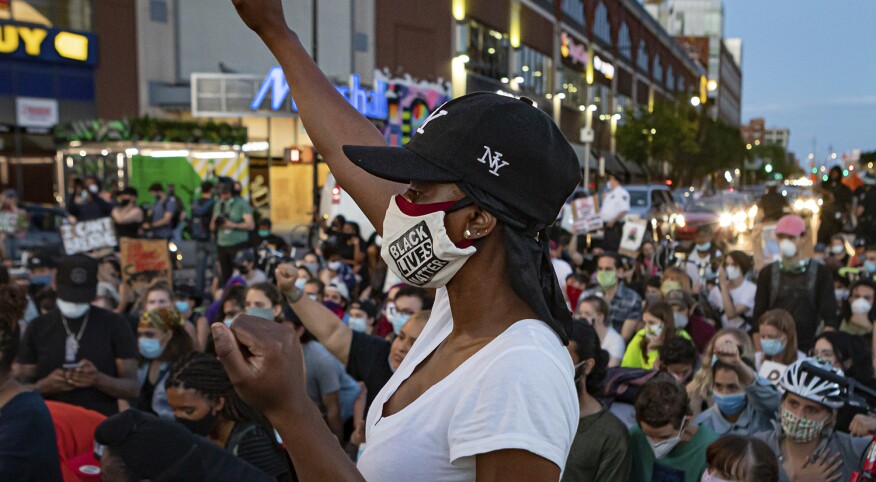Though I grew up in the noisy, protesting baby boom generation, protest marches had never been my thing. Not even during the heady days of the civil rights movement when marching became the centerpiece of activist protest. I had lost the passion early — at 16, after my parents refused to let me go to the only march I ever wanted to participate in: the great March on Washington in 1963 led by the mighty Martin Luther King, Jr. I was too young to go, my parents told me. It was too dangerous.
In later years, marches seemed anachronistic and too loud, too crowded. And what was the point, really? Does marching ever change anything? I admit I was among the cynics who thought the eruption of protests following George Floyd’s brutal killing by a Minneapolis police officer, who snuffed out his life with a knee to his neck, was just the expression of pent-up boredom from two months spent in self-isolation and social distancing due to COVID-19. Then I bore witness to the young protesters peacefully marching in Brooklyn right by my windows and below my balcony for eleven consecutive days.
The first day was Saturday, May 30, five days after George Floyd’s killing. I heard the marchers before I saw them. Roaring in the distance; the faint ringing of a cow bell announcing their advance. I went to the window. Hundreds of marchers, mostly young and of all races, were trooping up Flatbush Avenue, one of Brooklyn’s longest roadways, which runs all the way through the borough, from the base of the Manhattan Bridge to the sea at Jamaica Bay.
Walking in loose formation, yet way too close to be observing any social distance guidelines, these young marchers could have been my children. They were loud and boisterous, shouting a thunderous roll call to the haunting ding, ding of the cow bell. Ding. Ding: George Floyd. Ding. Ding: Ahmaud Arbery. Ding. Ding: Eric Garner. Ding. Ding: Breonna Taylor. Just a few of the names of the many thousands of African Americans gone, killed by police officers for as long as there have been police departments. George Floyd’s killing was so brutal that it set off largely peaceful protests against racial injustice in the U.S., first around the country and then around the world on a scale we’ve never seen in our lifetimes.
The next day the children were marching down Flatbush Avenue going toward Manhattan. In bigger numbers. Carrying cardboard signs that read “Black Lives Matter.” “No Justice, No Peace.” “I Can’t Breathe.” “Defund the Police.”
On the third straight day — actually at night — the children were marching up Flatbush heading to the Parkway, past the Brooklyn Public Library and the Botanic Gardens and the Brooklyn Museum. Something stirred in me, compelling me to run out of my apartment and join them. Old as I am. All of a sudden I wanted to be in the mix of youthful protest, to be part of the soaring new political energy I felt defined this moment.
I walked about half a mile, to the Brooklyn Museum, before dropping out, exhilarated to be in the thick of it for a minute, yet certain that I had to be the only one in my age group marching with a bunch of kids in the dead of night.
Then on the eighth straight day of protesting I heard the by now expected din of approaching protesters. I looked out the window and was stunned. Marching down Flatbush, taking up all six lanes, was a virtual tsunami of marchers — thousands upon thousands — moving as one in a single, swelling motion for as far as the eye could see, all the way to the colossal Barclay’s Center near the foot of the Manhattan Bridge. Horns blared in support. People on the sidelines clapped uproariously.
That’s when I felt the shift, for I suddenly realized I was watching a new generation of activists carrying a new torch, ignited and passed by a previous generation. The single-issue focus of my Black baby boom generation, obtaining civil rights historically denied because of race, was now being continued by the rainbow spectrum of politically active and committed younger people, the millennials of all colors and persuasions, who were connecting the dots in a way my generation did not.
The dot between one Black man’s brutal death at the hands of a racist police officer connected to the dot of over 100,000 deaths during a pandemic at the hands of failed political leadership. The dot between racial injustice anywhere connected to the dot of human injustice everywhere. This was the generation marching to the beat of inclusiveness, for we are indeed all in this together. One man’s senseless murder because of skin color threatens the life of everyone over anything.
Marching may not have been my thing in my youth, but I now understand that marchers march on through every generation and have a place for every time and circumstance, often changing style, but never substance. Because at any given time it may become necessary to put evil on notice publicly with a public protest — a protest to raise the issues, call the names, ring the cow bell.
Within ten days of sustained protests around the country and the world, Minneapolis banned the use of choke holds by the police, Arbery’s killers were arrested, Los Angeles diverted money from its $1.8 billion police budget into social programs and the U.S. Congress introduced legislation to reform law enforcement. These were but a few of the tangible changes ignited by peaceful protest, and for this a non-marching baby boomer can only say to her protesting children, “Right on!”

MIchael Nigro/Sipa USA, AP










